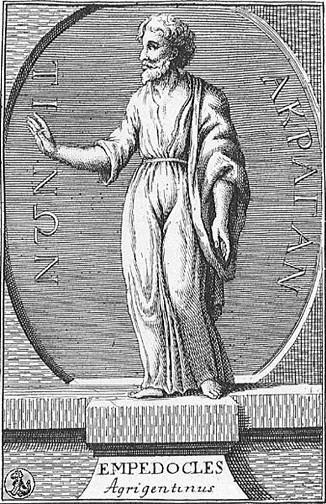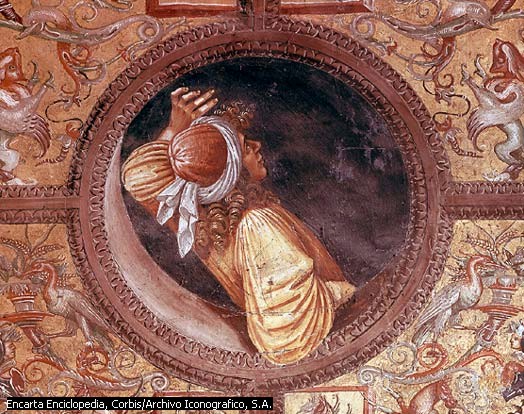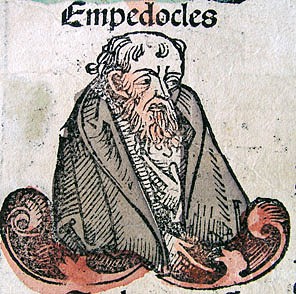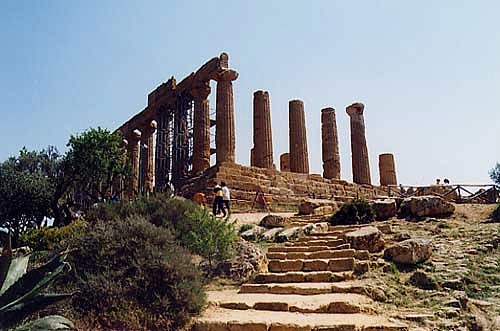Lessico
Empedocle

In greco Empedoklês. Filosofo greco (Agrigento ca. 492 - ? ca. 432 aC), l'ultimo dei grandi filosofi naturalisti presocratici, ebbe fama di medico e di guaritore e la sua figura divenne leggendaria. Partecipò alla vita politica della sua città, dalla quale pare sia stato esiliato, perché appartenente al partito democratico, quindi un acerrimo nemico della tirannia. Condusse una vita randagia in Sicilia, Magna Grecia e, probabilmente, nel Peloponneso. Era un personaggio stravagante, che si mostrava in giro vestito di porpora con un diadema in capo, circondato da discepoli adoranti e amava essere considerato un dio.
La sua morte resta misteriosa; si narrava però che, per far credere nella sua origine divina, si gettasse nell’Etna per sparire senza lasciare traccia, ma che fosse stato tradito dal fatto che il vulcano eruttò un suo sandalo.

Empedocle
scruta l'universo
Luca Signorelli (Cortona ca. 1445-1523)
Orvieto - Cappella Nuova
Nel poema Sulla natura Empedocle espone la sua concezione cosmologica, cercando la ragione del divenire e interpretandolo come mescolanza e dissoluzione delle quattro radici di tutte le cose, che egli identifica negli elementi ultimi della realtà: fuoco, acqua, terra e aria. Mediante tale teoria, Empedocle cerca di fondere le due scuole, eraclitea (moto) ed eleatica (essere, stato). Il divenire è determinato dall'azione di due forze opposte, l'Amore che tende a unire gli elementi e l'Odio che tende a dividerli. L'azione di queste forze genera i cicli cosmici. Quando domina esclusivamente l'Amore si ha lo Sfero e cioè la perfetta unità e armonia di tutte le cose in cui non c'è distinzione alcuna.
L'Odio separa questa unità e fa sorgere così le cose particolari, il mondo, che rappresenta la fase di equilibrio fra le forze opposte. L'Odio conduce poi alla dissoluzione delle cose e al caos finché l'Amore non interviene a invertire la tendenza per ripercorrere il ciclo.
Nel poema le Purificazioni Empedocle sostiene la teoria della metempsicosi con la quale si attua la legge di giustizia che esige l'espiazione delle colpe. Al valore speculativo del suo pensiero Empedocle unisce una notevole forza poetica, come si rileva dai frammenti pervenuti.
Empedocle
Empedocle (Empedoklês (Agrigento 492 aC ca. – 430 aC ca.) è stato un filosofo, poeta e scienziato greco antico, siceliota. Era di antica famiglia nobile e ricca di Agrigento. Come suo padre Metone, che ebbe un ruolo importante nell'allontanamento del tiranno Trasideo da Agrigento nel 470, Empedocle partecipò alla vita politica della città negli anni fra il 446 e il 444 aC, schierandosi dalla parte dei democratici e contribuendo al rovesciamento dell'oligarchia formatasi all'indomani della fine della tirannide, un governo chiamato dei "Cinquecento". Dai suoi nemici fu poi esiliato nel Peloponneso, dove forse conobbe Protagora e Erodoto. Tra i suoi discepoli vi fu anche Gorgia. Secondo il racconto di Diogene Laerzio, si iscrisse alla Scuola pitagorica divenendo allievo di Telauge, il figlio di Pitagora.Secondo altri seguì gli insegnamenti di Brontino e di Epicarpo.
Se della sua vita non abbiamo molti dati certi, la sua fama di mago contribuì, invece, a far nascere molte leggende sul suo conto. I suoi amici e discepoli raccontano ad esempio che alla sua morte, essendo amato dagli dei, fu assunto in cielo; i suoi detrattori, al contrario, riferiscono che caduto nella lava dell'Etna il vulcano avrebbe poi restituito solo i suoi calzari, tutto per dimostrare la sua divinità. In realtà non sappiamo neanche se sia morto in patria o, come sembra più probabile, nel Peloponneso. I Sicelioti lo veneravano come profeta e gli attribuivano numerosi miracoli.
A Empedocle la tradizione attribuisce numerose opere, fra cui anche alcuni trattati – sulla medicina, sulla politica e sulle guerre persiane – e tragedie. A noi sono giunti però solo frammenti dei due poemi: Sulla natura (Perì phýseos, titolo per altro comune a molte opere filosofiche antiche) e Purificazioni (Katharmoí). Della prima, di carattere cosmologico e naturalistico, sono rimasti circa 400 frammenti di diseguale ampiezza sugli originali 2000 versi, mentre della seconda, di carattere teologico e mistico, ne abbiamo poco meno di un centinaio rispetto agli originali 3000. La lingua da lui usata è il dialetto ionico. Il suo stile inoltre viene lodato dagli antichi. Cicerone (De Oratore 1, 217) afferma: «dicantur ei quos physikoús Graeci nominant eidem poetae, quoniam Empedocles physicus egregium poema fecerit» (siano pure detti poeti anche coloro che i Greci chiamano fisici, dal momento che il fisico Empedocle scrisse un poema egregio); Aristotele (fr. 1, 9, 65) lo definisce "padre della retorica"; Lucrezio (De rerum natura 727 ss.) lo prende addirittura come modello. Nel 1861, in suo onore gli viene intitolato il Regio Liceo Classico di Agrigento, fucina di grandi menti quali Pirandello, Sciascia, Cammilleri e tanti altri.
Il pensiero
La
filosofia di Empedocle si presenta come un tentativo di combinazione sintetica
delle precedenti dottrine ioniche, pitagoriche, eraclitee e parmenidee. Dalla
filosofia ionica e da quella di Eraclito egli accoglie l'idea del divenire,
del continuo e incessante mutamento delle cose. Da Parmenide, al contrario,
accetta la tesi dell'immutabilità e dell'eternità dell'Essere. Empedocle –
e come lui anche gli altri fisici pluralisti – risolve questa apparente
contraddizione distinguendo la realtà che ci circonda, mutevole, dagli
elementi primi, immutabili, che la compongono.
Empedocle chiama tali elementi radici e afferma che sono quattro: fuoco
(Zeus), aria (Era), terra (Idoneo) e acqua (Nesti). L'unione di tali radici
determina la nascita delle cose, la loro separazione la morte. Si tratta perciò
di apparenti nascite e apparenti morti, dal momento che l'Essere (le radici)
non si crea e non si distrugge, ma è soltanto in continua trasformazione.
L'aggregazione e la disgregazione delle radici sono determinate dalle due forze cosmiche e divine Amore e Discordia (o Odio), secondo un processo ciclico eterno. In una prima fase, tutti gli elementi e le due forze cosmiche sono riunite in un Tutto omogeneo, nello Sfero, il regno dove predomina l'Amore. A un certo punto, sotto l'azione della Discordia, inizia una progressiva separazione delle radici. L'azione della Discordia, non è ancora distruttiva, dal momento che le si oppone la forza dell'Amore, in un equilibrio variabile che determina la nascita e la morte delle cose, e con esse quindi il nostro mondo. Quando poi la Discordia prende il sopravvento sull'Amore, e ne annulla l'influenza, si giunge al Caos, dove regna la Discordia e dove è la dissoluzione di tutta la materia. A tal punto il ciclo continua grazie a un nuovo intervento dell'Amore che riporta il mondo alla condizione intermedia in cui le due forze cosmiche si trovano in nuovo equilibrio che dà nuovamente vita al mondo. Infine, quando l'Amore si impone ancora totalmente sulla Discordia si ritorna alla condizione iniziale dello Sfero. Da qui il ciclo ricomincia.
Il processo che porta alla formazione del mondo è quindi una progressiva aggregazione delle radici. Tale unione, lungi dall'avere un benché minimo carattere finalistico, è assolutamente casuale. E tale casualità si evidenzia a proposito degli esseri viventi. All'inizio infatti le radici si uniscono a formare arti e membra separati, che solo in seguito si uniranno, sempre casualmente tra di loro. Nascono così mostri di ogni specie (come ad esempio il Minotauro), che, dice Empedocle quasi anticipando Charles Darwin, sono scomparsi solo perché una selezione naturale favorisce alcune forme di vita rispetto ad altre, meglio organizzate e perciò più adatte alla sopravvivenza.
Le quattro radici sono anche alla base della gnoseologia di Empedocle. Egli infatti sostenne che i processi della percezione sensibile (essere modificati dagli oggetti esterni) e della conoscenza razionale fossero possibili solo in quanto esisteva un'identità di struttura fisica e metafisica tra il soggetto conoscente, ossia l’uomo, e l’oggetto conosciuto, ossia gli enti della natura. Sia l’uomo che gli enti erano formati da analoghe mescolanze quantitative delle quattro radici ed erano mossi dalle medesime forze attrattive e repulsive. Questa omogeneità rendeva possibile il processo della conoscenza umana, che si basava dunque sul criterio del simile, tesi esattamente opposta a quella di Anassagora: l’uomo conosceva le cose perché esse erano simili a lui. Infatti così affermò Empedocle: «noi conosciamo la terra con la terra, l’acqua con l’acqua, il fuoco con il fuoco, l’amore con l’amore e l’odio con l’odio».
Nelle Purificazioni Empedocle riprende la teoria orfica e pitagorica della metempsicosi, affermando l'esistenza di una legge di natura che fa scontare agli uomini i propri peccati attraverso una serie continua di nascite e di morti, tramite cui l'anima, di origine divina, trasmigra da un essere vivente all'altro (animale o vegetale) per millenni. Questa concezione conduce al rifiuto assoluto dei sacrifici, poiché in ogni essere vivente è un'anima umana, che sta compiendo il suo ciclo di reincarnazioni. Se nel corso di questo ciclo l'anima si è comportata bene, al termine potrà tornare nella sua condizione divina.
Fra le due opere vi sono delle contraddizioni che non è facile conciliare. Clamorosamente, ad esempio, alla visione quasi scientifica del poema Sulla natura si contrappone la teoria della reincarnazione delle Purificazioni: nel primo scritto l'anima è anche detta mortale, mentre è definita immortale nel secondo. C'è chi ha spiegato tali incongruenze con la versatilità di Empedocle, scienziato e profeta al tempo stesso, medico e taumaturgo contemporaneamente. C'è invece chi ha ipotizzato una paternità diversa delle due opere.

Empedocles
as portrayed
in the Nuremberg Chronicle - 1493
Empedocles (Greek: Empedoklês, ca. 490–430 BC) was a Greek pre-Socratic philosopher and a citizen of Agrigentum, a Greek colony in Sicily. Empedocles' philosophy is best known for being the origin of the cosmogenic theory of the four classical elements. He also proposed powers called Love and Strife which would act as forces to bring about the mixture and separation of the elements. These physical speculations were part of a history of the universe which also dealt with the origin and development of life. Influenced by the Pythagoreans, he supported the doctrine of reincarnation. Empedocles is generally considered the last Greek philosopher to record his ideas in verse. Some of his work still survives today, more so than in the case of any other Presocratic philosopher. Empedocles' death was mythologized by ancient writers, and has been the subject of a number of literary treatments.
Life

The
temple of Hera at Agrigentum
built when Empodecles was a young man, c. 470 BC.
Empedocles was born, c. 490 BC, at Agrigentum (Acragas) in Sicily to a distinguished family. Very little is known about his life. His father Meto seems to have been instrumental in overthrowing the tyrant of Agrigentum, presumably Thrasydaeus in 470 BC. Empedocles continued the democratic tradition of his house by helping to overthrow the succeeding oligarchic government. He is said to have been magnanimous in his support of the poor; severe in persecuting the overbearing conduct of the aristocrats; and he even declined the sovereignty of the city when it was offered to him.
His brilliant oratory, his penetrating knowledge of nature, and the reputation of his marvellous powers, including the curing of diseases, and averting epidemics, produced many myths and stories surrounding his name. He was said to have been a magician and controller of storms, and he himself, in his famous poem Purifications seems to have promised miraculous powers, including the destruction of evil, the curing of old age, and the controlling of wind and rain.
Empedocles was acquainted or connected by friendship with the physicians Acron and Pausanias; with various Pythagoreans; and even, it is said, with Parmenides and Anaxagoras. The only pupil of Empedocles who is mentioned is the sophist and rhetorician Gorgias.
Timaeus and Dicaearchus spoke of the journey of Empedocles to the Peloponnese, and of the admiration which was paid to him there; others mentioned his stay at Athens, and in the newly-founded colony of Thurii, 446 BC; there are also fanciful reports of him travelling far to the east to the lands of the Magi.
According to Aristotle, he died at the age of sixty, (c. 430 BC) even though other writers have him living up to the age of one hundred and nine. Likewise, there are myths concerning his death: a tradition, which is traced to Heraclides Ponticus, represented him as having been removed from the earth; whereas others had him perishing in the flames of Mount Etna.
Works
Empedocles is considered the last Greek philosopher to write in verse and the surviving fragments of his teaching are from two poems, Purifications and On Nature. Empedocles was undoubtedly acquainted with the didactic poems of Xenophanes and Parmenides - allusions to the latter can be found in the fragments, - but he seems to have surpassed them in the animation and richness of his style, and in the clearness of his descriptions and diction. Aristotle called him the father of rhetoric, and, although he acknowledged only the meter as a point of comparison between the poems of Empedocles and the epics of Homer, he described Empedocles as Homeric and powerful in his diction. Lucretius speaks of him with enthusiasm, and evidently viewed him as his model. The two poems together comprised 5000 lines. About 550 lines of his poetry survive, although because ancient writers rarely mentioned which poem they were quoting, it is not always certain to which poem the quotes belong. Some scholars now believe that there was only one poem, and that the Purifications merely formed the beginning of On Nature.
Purifications
We possess only about 100 lines of his Purifications. It seems to have given a mythical account of the world which may, nevertheless, have been part of Empedocles' philosophical system. The first lines of the poem are preserved by Diogenes Laërtius:
Friends who inhabit the mighty town by tawny Acragas
which crowns the citadel, caring for good deeds,
greetings; I, an immortal God, no longer mortal,
wander among you, honoured by all,
adorned with holy diadems and blooming garlands.
To whatever illustrious towns I go,
I am praised by men and women, and accompanied
by thousands, who thirst for deliverance,
some ask for prophecies, and some entreat,
for remedies against all kinds of disease.
It was probably this work which contained a story about souls, where we are told that there were once spirits who lived in a state of bliss, but having committed a crime (the nature of which is unknown) they were punished by being forced to become mortal beings, reincarnated from body to body. Humans, animals, and even plants are such spirits. The moral conduct recommended in the poem may allow us to become like gods again.
On Nature
There are about 450 lines of his poem On Nature extant, including 70 lines which have been reconstructed from some papyrus scraps known as the Strasbourg Papyrus. The poem originally consisted of 2000 lines of hexameter verse, and was addressed to Pausanias. It was this poem which outlined his philosophical system. In it, Empedocles explains not only the nature and history of the universe, including his theory of the four classical elements, but he describes theories on causation, perception, and thought, as well as explanations of terrestrial phenomena and biological processes.
Philosophy
Although acquainted with the theories of the Eleatics and the Pythagoreans, Empedocles did not belong to any one definite school. An eclectic in his thinking, he combined much that had been suggested by Parmenides, Pythagoras and the Ionian schools. He was both a firm believer in Orphic mysteries, as well as a scientific thinker and a precursor of physical science. Aristotle mentions Empedocles among the Ionic philosophers, and he places him in very close relation to the atomist philosophers and to Anaxagoras.
Empedocles, like the Ionian philosophers and the atomists, tried to find the basis of all change. They did not, like Heraclitus, consider the coming into existence and motion as the existence of things, and rest and tranquillity as the non-existence, because they had derived from the Eleatics the conviction that an existence could not pass into non-existence, and vice versa. In order to allow change to occur in the world, against the views of the Eleatics, they viewed changes as the result of mixture and separation of unalterable substances. Thus Empedocles said that a coming into existence from a non-existence, as well as a complete death and annihilation, are impossible; what we call coming into existence and death is only mixture and separation of what was mixed.
The four elements
It was Empedocles who established four ultimate elements which make all the structures in the world - fire, air, water, earth. Empedocles called these four elements "roots", which, in typical fashion, he also identified with the mythical names of Zeus, Hera, Nestis, and Aidoneus. Empedocles never used the term "element" (stoicheion), which seems to have been first used by Plato. According to the different proportions in which these four indestructible and unchangeable elements are combined with each other the difference of the structure is produced. It is in the aggregation and segregation of elements thus arising, that Empedocles, like the atomists, found the real process which corresponds to what is popularly termed growth, increase or decrease. Nothing new comes or can come into being; the only change that can occur is a change in the juxtaposition of element with element. This theory of the four elements became the standard dogma for the next two thousand years.
Love and Strife
The four elements are, however, simple, eternal, and unalterable, and as change is the consequence of their mixture and separation, it was also necessary to suppose the existence of moving powers - to bring about mixture and separation. The four elements are eternally brought into union, and eternally parted from each other, by two divine powers, Love and Strife. Love (Greek: f???a) explains the attraction of different forms of matter, and Strife (Greek: ?e????) accounts for their separation. If the elements are the content of the universe, then Love and Strife explain their variation and harmony. Love and Strife are attractive and repulsive forces which the ordinary eye can see working amongst people, but which really pervade the universe. They alternately hold empire over things, - neither, however, being ever quite absent.
The sphere of Empedocles
As the best and original state, there was a time when the pure elements and the two powers co-existed in a condition of rest and inertness in the form of a sphere. The elements existed together in their purity, without mixture and separation, and the uniting power of Love predominated in the sphere: the separating power of Strife guarded the extreme edges of the sphere. Since that time, strife gained more sway and the bond which kept the pure elementary substances together in the sphere was dissolved. The elements became the world of phaenomena we see today, full of contrasts and oppositions, operated on by both Love and Strife. The sphere being the embodiment of pure existence is the embodiment or representative of god. Empedocles assumed a cyclical universe whereby the elements return and prepare the formation of the sphere for the next period of the universe.
Cosmogony
Since the time of the sphere, Strife has gained more sway; and the actual world is full of contrasts and oppositions, due to the combined action of both principles. Empedocles attempted to explain the separation of elements, the formation of earth and sea, of sun and moon, of atmosphere. He also dealt with the first origin of plants and animals, and with the physiology of humans. As the elements entered into combinations, there appeared strange results - heads without necks, arms without shoulders. Then as these fragmentary structures met, there were seen horned heads on human bodies, bodies of oxen with human heads, and figures of double sex. But most of these products of natural forces disappeared as suddenly as they arose; only in those rare cases where the parts were found to be adapted to each other, did the complex structures last. Thus the organic universe sprang from spontaneous aggregations, which suited each other as if this had been intended. Soon various influences reduced the creatures of double sex to a male and a female, and the world was replenished with organic life. It is possible (although anachronistic) to see this theory as a crude anticipation of Darwin's theory of natural selection.
Perception and knowledge
Knowledge is explained by the principle that the elements in the things outside us are perceived by the corresponding elements in ourselves. Like is known by like. The whole body is full of pores, (and hence respiration takes place over the whole frame). In the organs of sense these pores are specially adapted to receive the effluences which are continually rising from bodies around us; and in this way perception is explained. Thus in vision, certain particles go forth from the eye to meet similar particles given forth from the object, and the resultant contact constitutes vision. Perception is not merely a passive reflection of external objects.
Empedocles noted the limitation and narrowness of human perceptions. We see only a part, but fancy that we have grasped the whole. But the senses cannot lead to truth; thought and reflection must look at the thing on every side. It is the business of a philosopher, while laying bare the fundamental difference of elements, to display the identity that exists between what seem unconnected parts of the universe.
Reincarnation
Like Pythagoras, Empedocles believed in the transmigration of the soul, that souls can be reincarnated between humans, animals and even plants. For Empedocles, all living things were on the same spiritual plane; plants and animals are links in a chain where humans are a link too. Empedocles urged a vegetarian lifestyle, since the bodies of animals are the dwelling places of punished souls. Wise people, who have learned the secret of life, are next to the divine, and their souls, free from the cycle of reincarnations are able to rest in happiness for eternity.
Death and literary treatments
Diogenes Laërtius records the legend that he died by throwing himself into an active volcano (Mount Etna in Sicily), so that people would believe his body had vanished and he had turned into an immortal god; however, the volcano threw back one of his bronze sandals, revealing the deceit. Another legend has it that he threw himself in the volcano to prove to his disciples that he was immortal; he believed he would come back as a god among man after being devoured by the fire.
In Icaro-Menippus, a comedic dialogue written by the second century satirist Lucian of Samosata, Empedocles’s final fate is re-evaluated. Rather than being incinerated in the fires of Mount Etna, he was carried up into the heavens by a volcanic eruption. Although a bit singed by the ordeal, Empedocles survives and continues his life on the moon, surviving by feeding on dew.
Empedocles' death has inspired two major modern literary treatments. Empedocles's death is the subject of Friedrich Hölderlin's play Tod des Empedokles (Death of Empedocles), two versions of which were written between the years 1798 and 1800. A third version was made public in 1826. In Matthew Arnold's poem Empedocles on Etna, a narrative of the philosopher's last hours before he jumps to his death in the crater first published in 1852, Empedocles predicts:
To the elements it came from
Everything will return.
Our bodies to earth,
Our blood to water,
Heat to fire,
Breath to air.
In 2006, a massive underwater volcano off the coast of Sicily was named Empedocles.